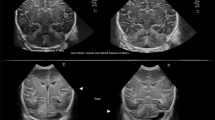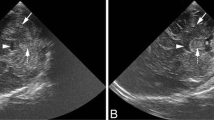Riassunto
Sebbene l’ecografia sia l’indagine di prima istanza nella valutazione delle anomalie della fossa cranica posteriore, la Risonanza Magnetica Fetale (RMF) rappresenta un utile complemento: ciò poiché offre una miglior risoluzione di contrasto e consente di ottenere immagini multiplanari che permettono di valutare il volume globale della fossa cranica posteriore, il tentorio cerebellare e la sua inserzione, la morfologia e la biometria del cervelletto, la morfologia del tronco encefalo e l’ampiezza degli spazi liquorali [1]. La RMF consente inoltre di ovviare al problema dell’ombra acustica legata alla progressiva ossificazione della teca e ai limiti dell’ecografia quando la posizione della testa fetale non consente di ottenere adeguate scansioni [2]. Inoltre, è indicata anche per la ricerca di anomalie sovratentoriali associate, che possono influenzare significativamente la prognosi [3]. Le anomalie della fossa cranica posteriore rilevabili in epoca prenatale comprendono la malformazione di Chiari II associata a difetti del tubo neurale, le anomalie “cistiche” (caratterizzate da ampliamento degli spazi liquorali sottotentoriali) e un gruppo eterogeneo di anomalie quali la romboencefalosinapsi, la romboencefaloschisi, le anomalie vascolari, le anomalie di segmentazione del tronco encefalo, dimorfismi della corteccia cerebellare e altre, nonché la patologia lesionale.
Access this chapter
Tax calculation will be finalised at checkout
Purchases are for personal use only
Preview
Unable to display preview. Download preview PDF.
Similar content being viewed by others
Bibliografia
Raybaud C, Levrier O, Brunei H et al (2003) MR imaging of fetal brain malformations. Childs Nerv Syst 19:455–470
Poutamo J, Vanninen R, Partanen K et al (1999) Magnetic resonance imaging supplements ultrasonographic imaging of the posterior fossa, pharynx and neck in malformed fetuses. Ultrasound Obstet Gynecol 13:327–334
Adamsbaum C, Moutard ML, André C et al (2005) MRI of the fetal posterior fossa. Pediatr Radiol 35:124–140
Bulas D (2010) Fetal evaluation of spine dysraphism. Pediatr Radiol 40:1029–1037
McLone DG, Dias MS (2003) The Chiari II malformation: cause and impact. Childs Nerv Syst 19:540–550
Chao TT, Dashe JS, Adams RC et al (2010) Central nervous system findings on fetal magnetic resonance imaging and outcomes in children with spina bifida. Obstet Gynecol 116:323–329
Hüsler MR, Danzer E, Johnson MP et al (2009) Prenatal diagnosis and postnatal outcome of fetal spinal defects without Arnold-Chiari II malformation. Prenat Diagn 29:1050–1057
Adzick NS, Thorn EA, Spong CY et al (2011) A randomized trial of prenatal versus postnatal repair of myelomeningocele. N Engl J Med 364:993–1004
Lavanya T, Cohen M, Gandhi SV et al (2008) A case of a Dandy-Walker variant: the importance of a multidisciplinary team approach using complementary techniques to obtain accurate diagnostic information. Br J Radiol 81:e242–e245
Ecker JL, Shipp TD, Bromley B et al (2000) The sonographic diagnosis of Dandy-Walker and Dandy-Walker variant: associated findings and outcomes. Prenat Diagn 20:328–332
Estroff JA, Scott MR, Benacerraf BR (1992) Dandy-Walker variant: prenatal sonographic features and clinical outcome. Radiology 185:755–758
Guibaud L (2004) Practical approach to prenatal posterior fossa abnormalities using MRI. Pediatr Radiol 34:700–711
Kollias SS, Ball WS Jr, Prenger EC (1993) Cystic malformations of the posterior fossa: differential diagnosis clarified through embryologic analysis. Radiographics 13:1211–1231
Strigini F, Valleriani A, Cecchi M et al (2009) Prenatal ultrasound and magnetic resonance imaging features in a fetus with Walker-Warburg syndrome. Ultrasound Obstet Gynecol 33:363–365
Limperopoulos C, Robertson RL, Estroff JA et al (2006) Diagnosis of inferior vermian hypoplasia by fetal magnetic resonance imaging: potential pitfalls and neurodevelopmental outcome. Am J Obstet Gynecol 194:1070–1076
Triulzi F, Parazzini C, Righini A (2006) Magnetic resonance imaging of fetal cerebellar development. Cerebellum 5:199–205
Doneda C, Parazzini C, Righini A et al (2010) Early cerebral lesions in cytomegalovirus infection: prenatal MR imaging. Radiology 255:613–621
Barth PG (2000) Pontocerebellar hypoplasia — how many types? Eur J Paediatr Neurol 4:161–162
Tortori-Donati P, Fondelli MP, Rossi A et al (1996) Cystic malformations of the posterior cranial fossa originating from a defect of the posterior membranous area. Mega cisterna magna and persisting Blake’s pouch: two separate entities. Childs Nerv Syst 12:303–308
Folkerth RD, McLaughlin ME, Levine D (2001) Organizing posterior fossa hematomas simulating developmental cysts on prenatal imaging: report of 3 cases. J Ultrasound Med 20:1233–1240
Napolitano M, Righini A, Zirpoli S et al (2004) Prenatal magnetic resonance imaging of rhomben-cephalosynapsis and associated brain anomalies: report of 3 cases. J Comput Assist Tomogr 28:762–765
Saleem SN, Zaki MS (2010) Role of MR imaging in prenatal diagnosis of pregnancies at risk for Joubert syndrome and related cerebelar disorders. AJNR Am J Neuroradiol 31:424–429
Merzoug V, Flunker S, Drissi C et al (2008) Durai sinus malformation (DSM) in fetuses. Diagnostic value of prenatal MRI and folow-up. Eur Radiol 18:692–699
McInnes M, Fong K, Grin A et al (2009) Malformations of the fetal durai sinuses. Can J Neurol Sci 36:72–77
Campi A, Scotti G, Filippi M et al (1996) Antenatal diagnosis of vein of Galen aneurysmal malformation: MR study of fetal brain and postnatal follow-up. Neuroradiology 38:87–90
Author information
Authors and Affiliations
Corresponding author
Editor information
Editors and Affiliations
Rights and permissions
Copyright information
© 2013 Springer-Verlag Italia
About this chapter
Cite this chapter
Doneda, C., Triulzi, F. (2013). Sistema nervoso centrale: patologie della fossa cranica posteriore. In: Fonda, C., Manganaro, L., Triulzi, F. (eds) RM fetale. Springer, Milano. https://doi.org/10.1007/978-88-470-1408-4_15
Download citation
DOI: https://doi.org/10.1007/978-88-470-1408-4_15
Publisher Name: Springer, Milano
Print ISBN: 978-88-470-1407-7
Online ISBN: 978-88-470-1408-4
eBook Packages: MedicineMedicine (R0)




